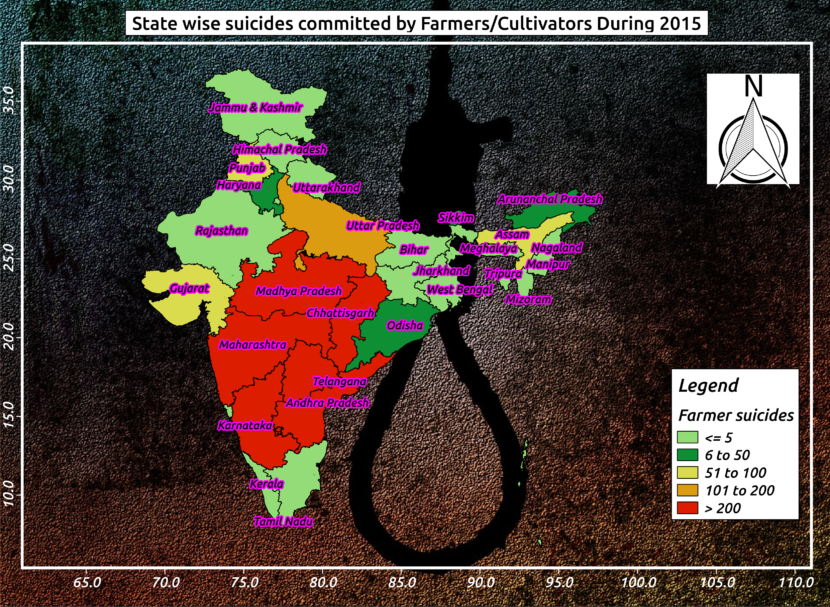Being an agrarian country, 48.9% of Indian population directly or indirectly depends on agriculture (Economic Survey 2014-15)1. A total of 12,602 farming sector persons (8,007 farmers/cultivators; 4,595 agricultural labourers) has committed suicides during 2015, accounting for 9.4% of total suicides victims (1,33,623) in the country (National Crime Records Bureau statistics, 2015)2. According to Milner, Spittal, Pirkis & LaMontagne (2013)3, it is evident that worldwide, farming is an occupation with a higher risk for suicide than other occupations. This is particularly true for small scale or marginal farmers (many of whom are below poverty line), cultivates land holdings of less than two hectares, constitute about 72% of total farmers in India (Agriculture Census 2010-11)4.
‘Bankruptcy or Indebtedness’ and ‘Farming related issues’ are major causes of suicides in India, accounting for 38.7% (3,097 out of 8,007 suicides) and 19.5% (1,562 out of 8,007 suicides) respectively of total farmers’ suicides during 2015 (NCRB, 2015). Kennedy and King (2014)5 found that the numbers of marginal farmers in different states are strongly linked to the suicide rate, along with indebtedness and cash crop production. The main source of capital for farming remains loan as the agricultural households made an average monthly income of Rs. 6426 and expenditure of Rs. 6223 (National Sample Survey Organisation’s (NSSO) report,2013)6. With so low income, unable to cope with mounting debt, farmers have higher psychological morbidity than the general population, many chose to end their lives.
Strategies for prevention of farmers’ suicides should have both short- and long-term interventions. Early identification and appropriate support to these farmers are urgently needed to prevent further suicides and farm related distress. For long term mitigation, a concrete reorientation of policy is crucial to stopping this depressing trend. Earlier Kisan Credit Cards were issued to the farmers under Agricultural Debt Waiver and Debt Relief Scheme, 2008. Various regional initiatives were launched by the government of India such as Maharashtra Bill to regulate farmer loan terms, 2008; Maharashtra relief package, 2010; Kerala Farmers’ Debt Relief Commission (Amendment) Bill, 2012; 2013 diversify income sources package (Parvathamma, 2016)7. In spite the fact that government has launched various schemes, the benefits of these schemes fails to reach the proper beneficiary.
The present government’s Pradhan Mantri Fasal Bima Yojana (PMFBY) promises a departure from the earlier crop insurance schemes which had low area coverage and amount offered to farmers was dismissal. Policy claims can’t even cover half of the value of produce when the crop suffers heavy damage due to lack of fine (farm) scale information. A possible solution to collect the data at farm scale is satellite remote sensing, a technology that is used to capture and upload data of crop cutting to reduce the delays in claim payment to farmers, Aapah Innovations Pvt. Ltd. is such a body that can provide information at a fine scale.The more lasting solution can be brought by Aapah Innovations by empowering farmers through scientific technology. All agricultural informatics for crop monitoring can be provided using satellite-based technology dissemination. This ensures the effective and efficient use of information and communication technologies for analysing, designing and implementing existing and innovative applications to help the agriculture sector.
Latest posts by Dr. Yukti Gill (see all)
- Happy 69th Indian Republic Day - January 26, 2018
- Dr. Ahmad Al Bitar joins our Technical Advisory Board - November 27, 2017
- VATI – watch your region in real time through our new App - November 19, 2017
India (2015). Economic Survey – 2015. The Government of India, Ministry of Finance. ↩
National Crime Reports Bureau, ADSI Report Annual – 2015 Government of India. Retrieved from http://ncrb.nic.in/StatPublications/ADSI/ADSI2015/chapter A%20suicides%20in%20farming%20sector.pdf ↩
Milner, A., Spittal, M. J., Pirkis, J., & LaMontagne, A. D. (2013).Suicide by occupation: systematic review and meta-analysis.Br J Psychiatry, 203 (2013), pp. 409–416 ↩
http://www.aapahinnovations.com/mapping-india-farmland-space/ ↩
Kennedy, J. & King, L. (2014).The political economy of farmers’ suicides in India: indebted cash-crop farmers with marginal landholdings explain state-level variation in suicide rates.Global Health, 10, p. 16 ↩
National Sample Survey Organisation’s (NSSO) report (2013). Retrieved from http://mospiold.nic.in/Mospi_New/upload/mospi_annual_report_2013-14.pdf ↩
Parvathamma, G. L.(2016). Farmers Suicide and Response of the Government of India -An Analysis. IOSR Journal of Economics and Finance (IOSR-JEF). 7( 3),01-06. ↩






